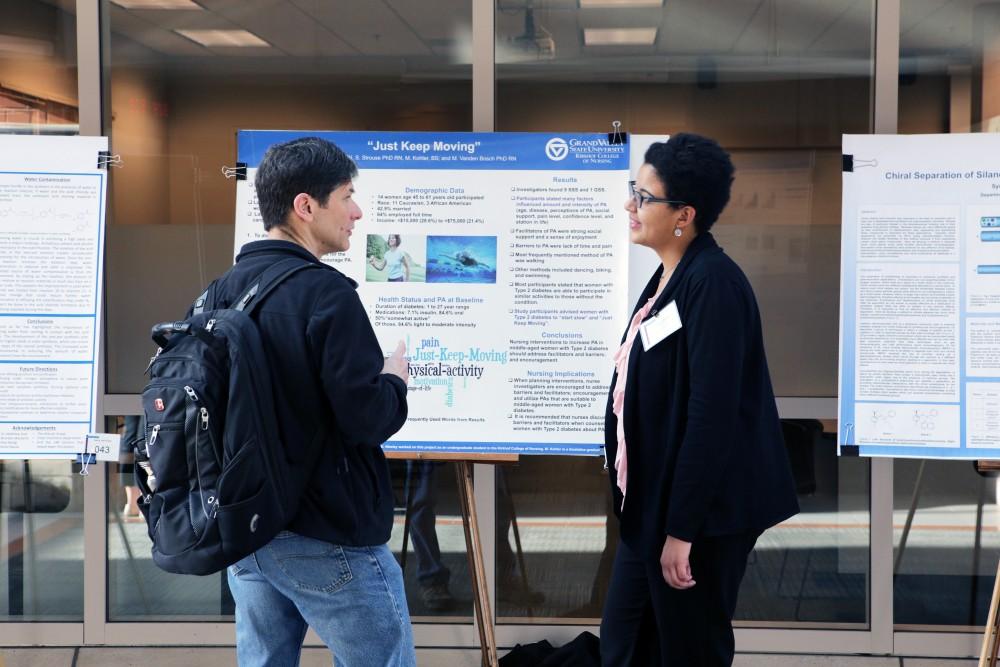A job well done

GVL / Emily Frye Student scholars day on Wednesday April 12, 2017.
Apr 13, 2017
With its mission to encourage student inquiry, scholarship and research, the Office of Undergraduate Research and Scholarship (OURS) at Grand Valley State University dedicates one day out of the entire year to celebrate students of all levels in their creative and scholarly endeavors. Student Scholars Day (SSD) was held Wednesday, April 12, in order to highlight students who have spent a great deal of time and effort researching a topic, creating a display and presenting their findings to the community.
With more than 400 presentations and close to 600 presenters participating in SSD, the Kirkhof Center, Henry Hall, and the Mary Idema Pew Library Learning and Information Commons were busy with students and faculty as research was presented throughout the day. SSD was filled with oral presentations, poster presentations, panel presentations, art exhibitions, live performances and a keynote lecture at the end of the day.
Susan Mendoza, director of OURS, said this opportunity allowed students to engage in research topics outside of the classroom, enabling them to gain knowledge and research experience.
“A lot of times in classes and courses, students will spend a large amount of time on research projects, either collaborative or individual,” Mendoza said. “There’s not always the opportunity to show those projects and to share those new ideas, their findings, their creative work, outside of the classroom.”
Mendoza said the difference between SSD and other research presentations is that SSD is not targeted toward one major, subject or field of study. Instead, it allows a diverse group of individuals to come together in one space in order to present their topics.
“You’ll have folks coming from across campus, whether we are talking about folks who traditionally hang out in the Lake buildings, traditionally over on the other side of Little Mac and Padnos or in Kindschi—they all come together in one venue to share their research experiences,” Mendoza said.
The research presented during SSD, gathered from either a course or an independent study, ranged from the effects of exercise to methods of fighting disease to finding the truth in history to sustainability. Mendoza said the diversity in topics stemmed from students having the opportunity to research any topic they were curious or passionate about.
“As you walk around, there are some students who their project might be related to their major, it might be related to their minor, or it might integrate the two or be completely independent,” Mendoza said. “It’s really up to them what they are curious about, what they’re interested in and what they are willing to devote the time to.”
This diversity allowed students like Ali Gillman, a GVSU senior pursuing a bachelor’s degree in fine arts with an emphasis in graphic design, to design an exercise application for her independent study.
“My project is called ‘Tag Team,’” Gillman said. “It’s an application that I designed mostly to help two people who can’t work out together on a regular basis to actually be able to do that. It sets you up by figuring out what kind of workouts you like; it helps you figure out what those workouts do and how to give you the correct form.
“It helps the pair become accountable for not only themselves, but to help each other to achieve their goals.”
Gillman said participating in SSD has allowed her to gain experience within her graphic design major, as well as obtain valuable skills that she will be able to utilize in her future career.
“In the real world, everything is on your own,” Gillman said. “You’re not always going to have a whole class to sit there and critique your work, and you’re not going to have the kind of support you usually get in the classroom. It helps you prepare for the real world.”
Along with the hundreds of presentations and posters lining the walls, Mendoza said OURS was initiating a lunch to celebrate students going onto graduate and professional schools after they graduate. This lunch, which is new this year, featured two siblings as keynote speakers, Delia Fernández, a historian of Latino/a history, and Nico Fernández, a Ph.D. candidate in microbiology and molecular genetics at Michigan State University. They shared their advice and keys to survival to the students being celebrated as they venture into graduate and professional programs.
SSD concluded with a keynote lecture from Liliana M. Dávalos, a professor of conservation biology/ecology and evolution and a research mentor at Stony Brook University. Her lecture, “The Importance of Models Dynamics of Extinction and Their Drivers From the Miocene to the Last 40 years,” took place at 7 p.m. in the Pere Marquette Room of the Kirkhof Center.

























